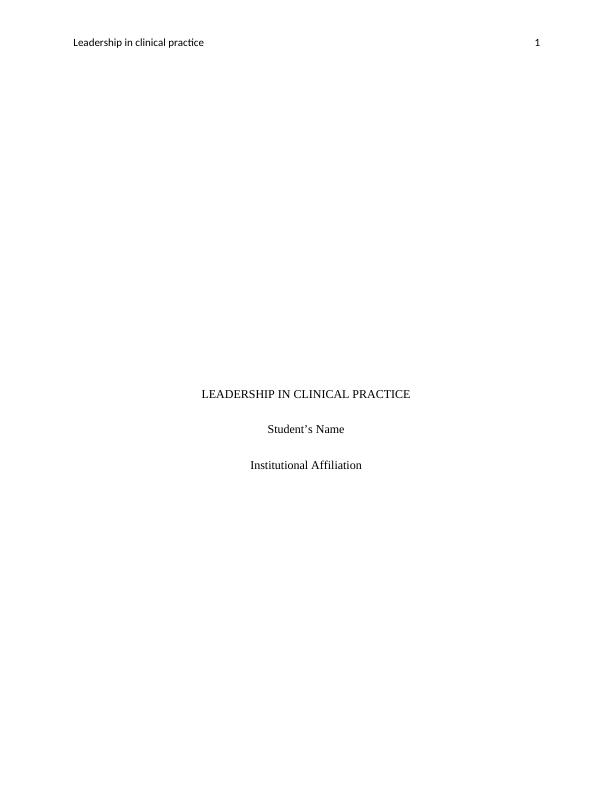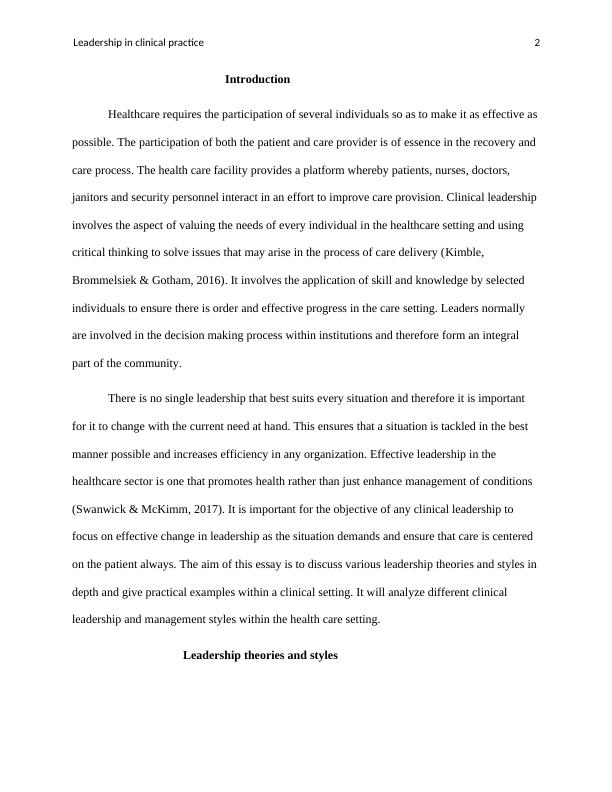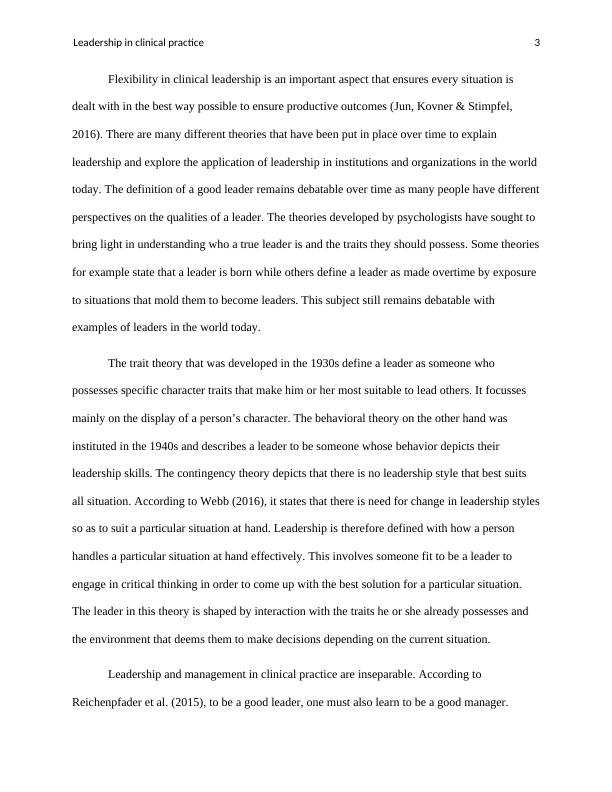Leadership in Clinical Practice
Added on 2023-04-21
8 Pages2214 Words137 Views
Leadership in clinical practice 1
LEADERSHIP IN CLINICAL PRACTICE
Student’s Name
Institutional Affiliation
LEADERSHIP IN CLINICAL PRACTICE
Student’s Name
Institutional Affiliation

Leadership in clinical practice 2
Introduction
Healthcare requires the participation of several individuals so as to make it as effective as
possible. The participation of both the patient and care provider is of essence in the recovery and
care process. The health care facility provides a platform whereby patients, nurses, doctors,
janitors and security personnel interact in an effort to improve care provision. Clinical leadership
involves the aspect of valuing the needs of every individual in the healthcare setting and using
critical thinking to solve issues that may arise in the process of care delivery (Kimble,
Brommelsiek & Gotham, 2016). It involves the application of skill and knowledge by selected
individuals to ensure there is order and effective progress in the care setting. Leaders normally
are involved in the decision making process within institutions and therefore form an integral
part of the community.
There is no single leadership that best suits every situation and therefore it is important
for it to change with the current need at hand. This ensures that a situation is tackled in the best
manner possible and increases efficiency in any organization. Effective leadership in the
healthcare sector is one that promotes health rather than just enhance management of conditions
(Swanwick & McKimm, 2017). It is important for the objective of any clinical leadership to
focus on effective change in leadership as the situation demands and ensure that care is centered
on the patient always. The aim of this essay is to discuss various leadership theories and styles in
depth and give practical examples within a clinical setting. It will analyze different clinical
leadership and management styles within the health care setting.
Leadership theories and styles
Introduction
Healthcare requires the participation of several individuals so as to make it as effective as
possible. The participation of both the patient and care provider is of essence in the recovery and
care process. The health care facility provides a platform whereby patients, nurses, doctors,
janitors and security personnel interact in an effort to improve care provision. Clinical leadership
involves the aspect of valuing the needs of every individual in the healthcare setting and using
critical thinking to solve issues that may arise in the process of care delivery (Kimble,
Brommelsiek & Gotham, 2016). It involves the application of skill and knowledge by selected
individuals to ensure there is order and effective progress in the care setting. Leaders normally
are involved in the decision making process within institutions and therefore form an integral
part of the community.
There is no single leadership that best suits every situation and therefore it is important
for it to change with the current need at hand. This ensures that a situation is tackled in the best
manner possible and increases efficiency in any organization. Effective leadership in the
healthcare sector is one that promotes health rather than just enhance management of conditions
(Swanwick & McKimm, 2017). It is important for the objective of any clinical leadership to
focus on effective change in leadership as the situation demands and ensure that care is centered
on the patient always. The aim of this essay is to discuss various leadership theories and styles in
depth and give practical examples within a clinical setting. It will analyze different clinical
leadership and management styles within the health care setting.
Leadership theories and styles

Leadership in clinical practice 3
Flexibility in clinical leadership is an important aspect that ensures every situation is
dealt with in the best way possible to ensure productive outcomes (Jun, Kovner & Stimpfel,
2016). There are many different theories that have been put in place over time to explain
leadership and explore the application of leadership in institutions and organizations in the world
today. The definition of a good leader remains debatable over time as many people have different
perspectives on the qualities of a leader. The theories developed by psychologists have sought to
bring light in understanding who a true leader is and the traits they should possess. Some theories
for example state that a leader is born while others define a leader as made overtime by exposure
to situations that mold them to become leaders. This subject still remains debatable with
examples of leaders in the world today.
The trait theory that was developed in the 1930s define a leader as someone who
possesses specific character traits that make him or her most suitable to lead others. It focusses
mainly on the display of a person’s character. The behavioral theory on the other hand was
instituted in the 1940s and describes a leader to be someone whose behavior depicts their
leadership skills. The contingency theory depicts that there is no leadership style that best suits
all situation. According to Webb (2016), it states that there is need for change in leadership styles
so as to suit a particular situation at hand. Leadership is therefore defined with how a person
handles a particular situation at hand effectively. This involves someone fit to be a leader to
engage in critical thinking in order to come up with the best solution for a particular situation.
The leader in this theory is shaped by interaction with the traits he or she already possesses and
the environment that deems them to make decisions depending on the current situation.
Leadership and management in clinical practice are inseparable. According to
Reichenpfader et al. (2015), to be a good leader, one must also learn to be a good manager.
Flexibility in clinical leadership is an important aspect that ensures every situation is
dealt with in the best way possible to ensure productive outcomes (Jun, Kovner & Stimpfel,
2016). There are many different theories that have been put in place over time to explain
leadership and explore the application of leadership in institutions and organizations in the world
today. The definition of a good leader remains debatable over time as many people have different
perspectives on the qualities of a leader. The theories developed by psychologists have sought to
bring light in understanding who a true leader is and the traits they should possess. Some theories
for example state that a leader is born while others define a leader as made overtime by exposure
to situations that mold them to become leaders. This subject still remains debatable with
examples of leaders in the world today.
The trait theory that was developed in the 1930s define a leader as someone who
possesses specific character traits that make him or her most suitable to lead others. It focusses
mainly on the display of a person’s character. The behavioral theory on the other hand was
instituted in the 1940s and describes a leader to be someone whose behavior depicts their
leadership skills. The contingency theory depicts that there is no leadership style that best suits
all situation. According to Webb (2016), it states that there is need for change in leadership styles
so as to suit a particular situation at hand. Leadership is therefore defined with how a person
handles a particular situation at hand effectively. This involves someone fit to be a leader to
engage in critical thinking in order to come up with the best solution for a particular situation.
The leader in this theory is shaped by interaction with the traits he or she already possesses and
the environment that deems them to make decisions depending on the current situation.
Leadership and management in clinical practice are inseparable. According to
Reichenpfader et al. (2015), to be a good leader, one must also learn to be a good manager.

End of preview
Want to access all the pages? Upload your documents or become a member.
Related Documents
Leadership in Health Carelg...
|8
|2014
|205
The Assignment on Nursing Leadership in Clinical Practicelg...
|14
|1021
|7
Leadership in Healthcarelg...
|9
|2520
|93
Assignment on Transcript Leadership In Clinical Nursinglg...
|5
|1145
|5
Nursing Leadership: Role of Clinical Leaders in Healthcare Professionlg...
|14
|3537
|189
Leadership in Nursinglg...
|1
|821
|57
